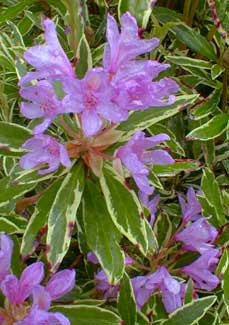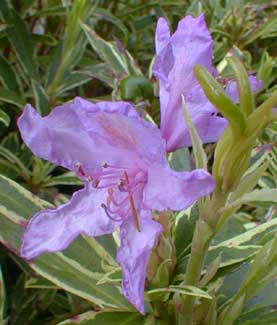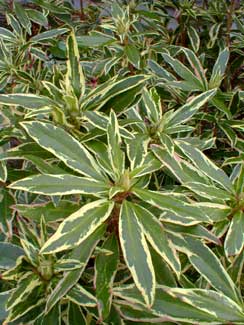
Variegated
Pontus
Rhododendron
"Sorrow take a purple diadem."
-Oscar Wilde
 Rhododendron ponticum var cheireanthifolium 'Variegatum' is one of the more commonly available variegated rhododendrons.
Rhododendron ponticum var cheireanthifolium 'Variegatum' is one of the more commonly available variegated rhododendrons.It is a sport of the 'Cheiranthifolium' form of the species, having smaller narrower leaves than the species, with wavy margins. The leaves of 'Variegatum' are emerald green with cream edges, a very striking shrub with or without flowers.
The species is very sun tolerant, but the variegated form can be scorched from too much afternoon sun exposure. This specimen at a friend's estate where I've done a lot of the landscaping does get full afternoon sun & does suffer some scorch as a result. I've not considered moving it to a more appropriate location since a nearby Japanese maple is getting broader & taller every year & the rhody gets a bit more protection each year.
Flower color can vary on this variety, but this one has fairly typical lavender-blue flowers which occur late May & early June.
The Massachusetts chapter of the American Rhododendron Society listed 'Variegatum' as "provisionally recommended" rather than as one of the ultra hardy ironclads. The condition of variegation for most species all too often means a somewhat weakened plant that would not have thrived without human assistance. Variegated plants in general produce less chlorophyll so grow more slowly, & pale parts of leaves are more susceptible to sunburns.
 The Variegated Pontus Rhododendron may also flower less reliably because the buds are susceptible to fungal blight or buds can fail to open from being blasted by the sun. The sun-stressed specimen I've photographed has not flowered mightily, & will likely do better when the maple's spread provides it a more dappled sunlight, but it has performed semi-well & is certainly never in any manner unpleasant.
The Variegated Pontus Rhododendron may also flower less reliably because the buds are susceptible to fungal blight or buds can fail to open from being blasted by the sun. The sun-stressed specimen I've photographed has not flowered mightily, & will likely do better when the maple's spread provides it a more dappled sunlight, but it has performed semi-well & is certainly never in any manner unpleasant.The shrub has also been known to partially revert, producing limbs that are not variegated, though this problem is rare enough I wouldn't take it too seriously. If an unvariegated branch begins to develop it can just be pruned out before it gets very far. Its not a good idea to let such a branch continue to develop because it would have an edge over the rest of the shrub, having more chlorophyll production & swifter growth.
The species is an invasive pest in parts of England. But the variegated form, although a cloned mutation rather than a hybrid cultivar hence itself a species shrub, is restrained. Its ten-year height, upright & mounding, is three to five feet with four to five foot spread. It's cold-hardy to minus 20 degrees F.
The Pontus rhododendron is toxic & the honey bees of the Pontus region have adapted to its toxicity in order to make "mad honey" which causes intoxication. For a fascinating history of R. ponticum toxicity, see the separate article on the so-called "Mad Honey Disease." See also another Pountus cultivar, Rhododendron ponticum 'Daphnoides'